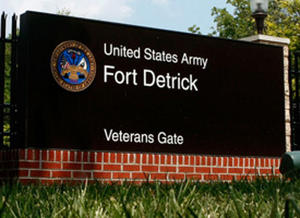NRC panel has "high confidence" in Fort Detrick BioLab's security procedures
The U.S. Army plans to expand its biocontainment laboratories at Fort Detrick in Frederick, Maryland, to study deadly pathogens; a few incidents at the lab heightened security concerns in the neighboring communities, but National Research Council report finds that current safety procedures and regulations at the labs meet or exceed accepted standard

Fort Detrick. Maryland // Source: isiria.wordpress.com
A new National Research Council report requested by Congress finds several problems in an environmental impact statement prepared by the U.S. Army for its expansion of biocontainment laboratories at Fort Detrick in Frederick, Maryland, to study deadly pathogens. The report adds that current safety procedures and regulations at the labs meet or exceed accepted standards, giving the committee that wrote the report a “high degree of confidence” that appropriate protections for workers and the public are in place (see “Citizens Worried about Fort Detrick Biolab,” 28 September 2009 HSNW).
The committee held public meetings to gather information from officials of the U.S. Army Medical Research Institute of Infectious Diseases (USAMRIID) and contractors involved in the development of its environmental impact statement, as well as from Fort Detrick emergency personnel, the Frederick County Board of Commissioners, and members of the local community. The committee also met with officials from Frederick Memorial Hospital and Frederick County’s emergency management and health departments.
The environmental impact statement estimated the effects of potential mishaps at the new USAMRIID facilities, including “maximum credible event” scenarios where Ebola virus and the bacteria that causes Q fever are released from an exhaust stack. The committee, however, could not verify the estimate that such an event would lead to insignificant ground concentrations in the surrounding environment and would not pose a hazard to the nearby community. The data to support this estimate was lacking, missing, or not transparent in the statement, according to the committee, whose own calculations indicated the potential for significantly higher exposure to those in the surrounding area. An exceptionally large aerosol release of a pathogen might pose a health risk, but the committee said this is an inappropriate maximum credible event because there are no reasonably foreseeable scenarios where such a release could occur, the committee noted.
In addition, the environmental impact statement did not adequately document or characterize individual risk of exposure or infection, nor did it consider potential exposures to workers and others on the base itself or how the spread of a pathogen would be affected by population size and density. Although Congress mandated the new labs be located at Fort Detrick as part of a larger biodefense campus, it would have been appropriate for the statement also to consider risks at an alternative location, such as in a less populated area, which would have provided a comparison helpful for evaluating risk-management strategies.
Despite
